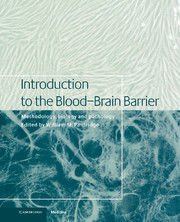Book contents
- Frontmatter
- Contents
- List of contributors
- 1 Blood–brain barrier methodology and biology
- Part I Methodology
- Part II Transport biology
- Part III General aspects of CNS transport
- Part IV Signal transduction/biochemical aspects
- 31 Regulation of brain endothelial cell tight junction permeability
- 32 Chemotherapy and chemosensitization
- 33 Lipid composition of brain microvessels
- 34 Brain microvessel antigens
- 35 Molecular dissection of tight junctions: occludin and ZO-1
- 36 Phosphatidylinositol pathways
- 37 Nitric oxide and endothelin at the blood–brain barrier
- 38 Role of intracellular calcium in regulation of brain endothelial permeability
- 39 Cytokines and the blood-brain barrier
- 40 Blood–brain barrier and monoamines, revisited
- Part V Pathophysiology in disease states
- Index
40 - Blood–brain barrier and monoamines, revisited
from Part IV - Signal transduction/biochemical aspects
Published online by Cambridge University Press: 10 December 2009
- Frontmatter
- Contents
- List of contributors
- 1 Blood–brain barrier methodology and biology
- Part I Methodology
- Part II Transport biology
- Part III General aspects of CNS transport
- Part IV Signal transduction/biochemical aspects
- 31 Regulation of brain endothelial cell tight junction permeability
- 32 Chemotherapy and chemosensitization
- 33 Lipid composition of brain microvessels
- 34 Brain microvessel antigens
- 35 Molecular dissection of tight junctions: occludin and ZO-1
- 36 Phosphatidylinositol pathways
- 37 Nitric oxide and endothelin at the blood–brain barrier
- 38 Role of intracellular calcium in regulation of brain endothelial permeability
- 39 Cytokines and the blood-brain barrier
- 40 Blood–brain barrier and monoamines, revisited
- Part V Pathophysiology in disease states
- Index
Summary
Introduction
At the present time, it is generally accepted that the blood-brain barrier (BBB) represents a conglomeration of regulatory systems concerned with maintaining a homeostatic biochemical environment for the brain parenchyma. The concept of a barrier between the blood and brain originated almost a century ago with Ehrlich's studies demonstrating that injection of certain aniline dyes stained peripheral organs and tissues but not the brain (Ehrlich, 1902). This notion was expanded by Goldman (1909) who showed that directly injecting vital dyes into the cerebrospinal fluid (CSF) stained the entire brain without affecting peripheral organs and tissues. Notably, Goldman was the first to suggest that intraparenchymatous cerebral capillaries play a role in restricting the passage of the dyes between the blood and the brain or vice versa.
The morphological confirmation for existence of the BBB at the level of brain capillaries was demonstrated by electron microscopy (Reese and Karnovsky, 1967). It has been shown that the endothelial cells, which comprise the brain capillaries and microvessels but not those in the peripheral vasculature, are connected by continuous belts of tight junctions, devoid of fenestrae and containing a few vesicles. Interestingly, the micro vascular endothelium of the choroid plexus and circumventricular organs lack these properties; the blood- CSF barrier of the choroid plexus is formed by tight junctions between epithelial cells (Lindvall et al., 1980; Rapoport, 1976).
- Type
- Chapter
- Information
- Introduction to the Blood-Brain BarrierMethodology, Biology and Pathology, pp. 362 - 376Publisher: Cambridge University PressPrint publication year: 1998
- 2
- Cited by



